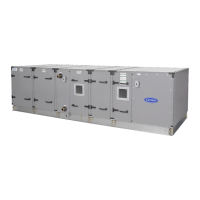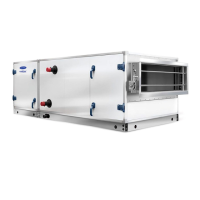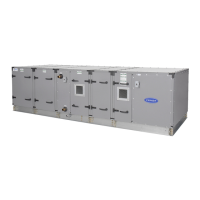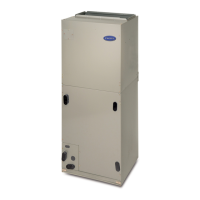45MUAAQ: Owner’s Manual
Manufacturer reserves the right to change, at any time, specifications and designs without notice and without obligations.
5
5. Presence of fire extinguisher
If any hot work is to be conducted on the refrigeration equipment
or any associated parts, appropriate fire extinguishing equipment
shall be available to hand. Have a dry power or CO2 fire
extinguisher adjacent to the charging area.
6. No ignition sources
No person carrying out work in relation to a REFRIGERATING
SYSTEM which involves exposing any pipe work shall use any
sources of ignition in such a manner that it may lead to the risk of
fire or explosion. All possible ignition sources, including cigarette
smoking, should be kept sufficiently far away from the site of
installation, repairing, removing and disposal, during which
refrigerant can possibly be released to the surrounding space. Prior
to work taking place, the area around the equipment is to be
surveyed to make sure that there are no flammable hazards or
ignition risks. “No Smoking” signs shall be displayed.
7. Ventilated area
Ensure that the area is in the open or that it adequately ventilated
before breaking into the system or conducting any hot work. A
degree of ventilation shall continue during the period that the work
is carried out. The ventilation should safely disperse any released
refrigerant and preferably expel it externally into the atmosphere.
8. Checks to the refrigeration equipment
Where electrical components are being changed, they shall be fit
for the purpose and to the correct specification. At all times the
manufacturer’s maintenance and service guidelines shall be
followed. If in doubt consult the manufacturer’s technical
department for assistance. The following checks shall be applied to
installations using FLAMMABLE REFRIGERANTS:
• The actual refrigerant charge is in accordance with the room size
within which the refrigerant containing parts are installed;
• The ventilation machinery and outlets are operating adequately and are
not obstructed;
• If an indirect refrigerating circuit is being used, the secondary circuits
shall be checked for the presence of refrigerant;
• Marking to the equipment continues to be visible and legible, marking
and signs that are illegible shall be corrected;
• Refrigeration pipe or components are installed in a position where they
are unlikely to be exposed to any substance which may corrode
refrigerant containing components, unless the components are
constructed of materials which are inherently resistant to being
corroded or are suitably protected against being so corroded.
9. Checks to electrical devices
Repair and maintenance to electrical components shall include initial
safety checks and component inspection procedures. If a fault exists
that could compromise safety, then no electrical supply shall be
connected to the circuit until it is satisfactorily dealt with. If the fault
cannot be corrected immediately but it is necessary to continue
operation, and adequate temporary solution shall be used. This shall
be reported to the owner of the equipment so all parties are advised.
Initial safety checks shall include:
• That capacitors are discharged: this shall be done in a safe manner to
avoid possibility of sparking
• That there no live electrical components and wiring are exposed while
charging, recovering or purging the system
• That there is continuity of earth bonding
10. Sealed electrical components shall be replaced.
11. Intrinsically safe components must be replaced.
12. Cabling
Check that cabling is not subjected to wear, corrosion, excessive
pressure, vibration, sharp edges or any other adverse environmental
effects. The check shall also take into account the effects of aging or
continual vibration from sources such as compressors or fans.
13. Detection of flammable refrigerants
Under no circumstances shall potential sources of ignition be used in
the searching for or detection of refrigerant leaks. A halide torch (or
any other detector using a naked flame) shall not be used.
The following leak detection methods are deemed acceptable for
refrigerant systems. Electronic leak detectors that have a sensitivity
of 1/8 oz (5g) may be used to detect refrigerant leaks but, in the case
of FLAMMABLE REFRIGERANTS, the sensitivity may not be
adequate, or may need re-calibration. (Detection equipment shall be
calibrated in a refrigerant-free area.) Ensure that the detector is not a
potential source of ignition and is suitable for the refrigerant used.
Leak detection equipment shall be set at a percentage of the LFL of
the refrigerant and shall be calibrated to the refrigerant employed,
and the appropriate percentage of gas (25% maximum) is confirmed.
Leak detection fluids are also suitable for use in external leak
detection.
NOTE: Examples of leak detection fluids are as follows:
• Bubble method
• Fluorescent method agents
If a leak is suspected, all naked flames shall be removed/extinguished.
If a leakage of refrigerant is found which requires brazing, all of the
refrigerant shall be recovered from the system, or isolated (by means of
shut off valves) in a part of the system remote from the leak. See the
following instructions of removal of refrigerant.
14. Removal and evacuation
When breaking into the refrigerant circuit to make repairs - or for
any other purpose conventional procedures shall be used. However,
for flammable refrigerants it is important that best practice be
followed, since flammability is a consideration.
The following procedure shall be adhered to:
a. safely remove refrigerant following local and national
regulations;
b. evacuate;
c. purge the circuit with nitrogen;
d. evacuate;
e. continuously flush or purge with nitrogen when using flame to
open circuit; and open the circuit.
The refrigerant charge shall be recovered into the correct recovery
cylinders. Charging must be performed by liquid charging method. For
appliances containing flammable refrigerants, the system shall be purged
with oxygen-free nitrogen to render the appliance safe for flammable
refrigerants. This process might need to be repeated several times.
Compressed air or oxygen shall not be used for purging refrigerant
systems.
For appliances containing flammable refrigerants, refrigerants purging
shall be achieved by breaking the vacuum in the system with oxygen-free
nitrogen and continuing to fill until the working pressure is achieved, then
venting to atmosphere, and finally pulling down to a vacuum (optional for
A2L). This process shall be repeated until no refrigerant is within the
system (optional for A2L). When the final oxygen-free nitrogen charge is
used, the system shall be vented down to atmospheric pressure to enable
work to take place.
The outlet for the vacuum pump shall not be close to any potential
ignition sources, and ventilation shall be available.
15. Charging procedures
In addition to conventional charging procedures, the following
requirements shall be followed:

